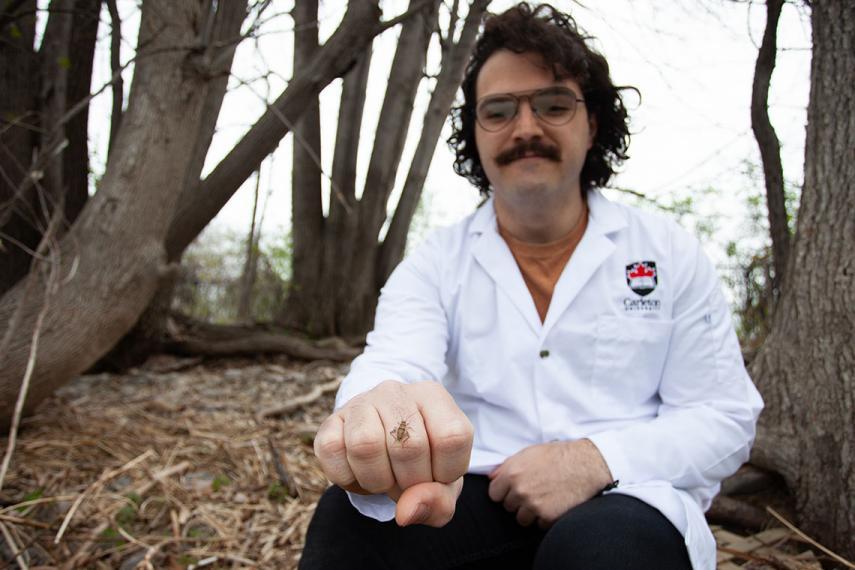Insects for dinner, anyone?

Featuring Matt Muzzatti, M.Sc. in Environmental Science 2019
They’re not your typical meat and potatoes. But protein- and vitamin-rich crickets could provide a more sustainable option for your dinner table.
Raised for human consumption, crickets and other insects are being re-introduced into North American diets.
“Insects are a sustainable super-food,” says Matt Muzzatti, M.Sc. 2019, and now a PhD candidate at Carleton University. “They are extremely healthy for you and require a lot less water, land use and feed to produce a comparable amount of protein as cows, chickens or pigs.”
Matt is a cricket nutritionist of sorts.
Through diet manipulation, he is trying to raise bigger insects. Working with Entomo Farms, North America’s largest cricket farm, Matt is researching ways to improve the nutrition of their commercially reared cricket species, Gryllodes sigillatus, commonly known as the “tropical house cricket” or “banded cricket.”
He is raising thousands of individual crickets and feeding them specific diets. He alters the ratios of macronutrients, carbohydrates and protein, and tracks performance, growth development and other changes.
Matt keeps each cricket in its own small plastic cup, with a custom-made lid for ventilation. Each insect has its own tiny feeding dish, a water vial plugged with cotton and a piece of egg carton for shelter. He weighs the crickets weekly and takes a top-down photo for body size measurements calculated on a computer.
“We normally rear between 120 to 300 crickets at once, so this quickly adds up to a lot of labour,” says Matt. “I am grateful we have an incredible team of undergraduate students who help in the lab. Our work wouldn’t be possible without them.”
He aims to help Entomo Farms and other cricket farmers find the optimal diet to achieve peak performance and raise yields without increasing cost.
“Like my research, there is a lot of manual labour involved in cricket farming, which is keeping the product price high. If we can find ways to increase yield without increasing costs and save time, it could be a really productive way to improve the industry,” he explains.
Matt incorporates insects into his meals a few times a week and encourages others to do the same.
“The ‘ick’ factor is the largest hurdle for people to get over. Humans have consumed inspects for as long as we can trace human life, and it is something they have transitioned away from in this part of the world. Through colonization, insect eating was perceived as a poor person’s food or a nasty behaviour.”
Around the world, people eat more than 1,600 insect species. Grasshoppers, caterpillars, ants, termites and insect larvae are even considered a delicacy in Africa, Asia, Central America and Mexico. “North America needs to catch up. We don’t have a diversity of products on the market. Cricket protein powder dominates, but I think we will see a slow progression of new products.”
Matt knows insect-eating will require a change in perspective. He says most people bucket insects into two categories: the “gross and dirty” and the “good and pollinating.” Scientists and enthusiasts like Matt are trying to improve people’s perception of eating bugs.
“There are too many good reasons to use insects as a form of protein. I think one reason people are so hesitant is because they haven’t tried a well-prepared dish using insect ingredients. It can be a great-tasting ingredient.”
Add crickets to the menu
Crickets contain all nine essential amino acids and are rich in protein, calcium and iron. Plus, they are a source of beneficial dietary fibre. Here are four ways you can incorporate crickets into your day:
- BREAKFAST // Add a scoop of cricket protein powder to your smoothie.
- SNACK // Enjoy whole roasted crickets for a healthy afternoon snack.
- DINNER // Incorporate cricket protein powder into your favourite chili recipe.
- DESSERT // Add cricket protein powder to your favourite cookie or cupcake recipe.
Visit entomofarms.com for recipes.
This article was originally published in the LIBRANNI 2023 / Vol. 5